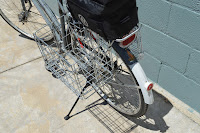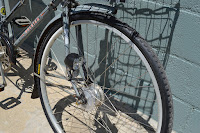There's kind of a lot going on here.
Yet another Raleigh Sports to enter my stable. This time from somebody else's stable, literally.
I stumbled upon this bike on craigslist one day, being sold by the original owner. She bought it new in 1969 and used it as her primary transport in the Northeast for decades. When she arrived with it, it was attached to a bit of hay and what looked like other farm-related debris. It hadn't seen the road in quite a while.
It had a well-worn, original Brooks B72 saddle, but not much else. Well, the wheels were straight, and what was left of the bike was actually pretty solid. At first, I was considering parting it out to help with my other builds but decided to build it into a cargo bike of sorts.
I bought and painted a rear fender that looked similar to the original (it was alloy, and the least expensive I could find), re-packed the wheel and headset bearings, replaced the cables, removed the rusted generic replacement shifter and threw on a period-correct Sturmey-Archer unit from the parts pile. I added an extended seat post with my beloved Serfas spring saddle and ran it for several months as a loaner bike. The first friend to ride it actually tried it before I did, only days after I had finished the aforementioned fixes. I let her pick out a name, which ended up being Marco. The last person to ride it was no stranger to my collection of vintage Raleighs, and was able to enjoy it in its final days before I added the baskets. In the meantime, I occasionally rode the bike to and from work. I felt that this was my "lightest-feeling" 3-speed for some reason - I mean, it probably was the lightest with that alloy fender and no attachments, but the ancient, dry-rotted Spitfire tires also had a nice feel to them.
One night, I made the impulsive and ultimately great decision to take another crack at building a hybrid drivetrain. Initially, the 48/22 gear ratio was great for taking off but too easy to max out on flat ground. I took out the two spacers that came on the hub, added a 20t dished cog, and faced the two sprockets back to back on the driver of the hub. They fit perfectly.
It started because I always wanted the excuse to use an old Raleigh brake lever with the hinge screw tightened down to make it function as a friction shifter. With this bike, and the fact that it only needed two gear positions, the application was perfect. I figured that in-between ratios would be a welcome addition to a load-carrying bike. I was able to continue using the 1/8" chain and therefore not bother with grinding down the cogs. The 20-22 cogs offer pretty good splitting of the gear steps in the 3-speed hub and since the difference is only two teeth, the chain derails smoothly on command despite it being the 1/8" kind. I used a cheap Sunlite derailleur and the additional guard actually protrudes past the indicator chain for the hub so everything fragile is more or less protected from bumps and nicks. If you look closely at the shift lever on the top tube, you may be able to see that I ground a channel into the part that sits against the frame so the rear brake cable could pass through it uninterrupted.
Onto the rest ... Rather than attaching the front basket to the handlebars and fork as people usually do, I opted to mount it to the frame so that steering would not be heavy and floppy. Certain cargo bikes have baskets mounted this way as well. I drilled holes straight through the head tube lugs (behind the head tube, of course) and only then did I tear down the bottom bracket to clean the metal shavings out and re-pack the bearings. I constructed a frame out of 1/8" x 3/4" steel bar with M8 bolts and JB Weld used in conjunction it so it wouldn't shake. I JB Welded the individual washers, bolts, nuts, and members together during assembly for extra strength and did my best to cover up the holes left from drilling. It ain't pretty, but it works.
The front basket is removable, kind of. Four nuts and bolts need to be loosened so it's not all that convenient but the option is there. I predict that I will not need to do this very much because I have several other Raleigh 3-speeds to choose from if I want to ride without a basket ...
Full disclosure: I forgot to add the drain and front kickstand before the first set of photos was taken
Because I am a paranoid person and still afraid of rain water gathering in the bottom of the frame, I drilled a bung hole in the bottom bracket shell for drainage and added a sawed-off bulkhead nozzle so dirty water would less likely be splashed back up into it by the wheel.
The business in the rear was a bit more straightforward - steel rack, Nashbar trunk bag, and steel Wald 582 folding baskets. The baskets were bought as a pair over a year ago, and one of them was used on my '79 Superbe until I unbuilt it. In the drivetrain photos further above, you will see how I had to extend the rack stays. I forgot to paint those bits and will do that after I have a chance to weld it up. The fact that Raleigh placed their fender/rack eyelets behind the dropout and not above it makes it so most "26-inch" and even certain 700c racks don't have long-enough legs.
As it was before, the bike loved to go and did not like to stop. It's still like that, but to a lesser degree in both respects. Not much, though. I replaced the rear caliper with a Tektro long reach unit that works a bit better, and the front received the Sun CR-18 rim and Sturmey-Archer X-FDD drum brake dynohub that came from my Superbe. I may have said this before, but the benefit of drum brakes is not their sheer power, but that they perform consistently in all weather conditions. That being said, it is still more powerful than the original caliper brake. I always have to remember to squeeze the rear brake much harder so that the fork isn't taking up all of the force when I need to slow down.
Other things worth mentioning are the lighting system, which is all-standlight, 6-volt 3-watt front and rear from Herrmans, and the tires, which are Kenda K146. I thought, since this was going to my grocery-getter or "beach bike" (in which I'd be carrying gear to the river with friends or whatever, hence the barefoot pedals), that I would like to have some knobbier treads. The knobs ended up looking taller in the photo than they were in real life and the tires seemed quite thin so I also used some Rhinodillo puncture protection strips because flipping such a heavy bike over to change a tire is a real pain.
I used a 1969 Schwinn chain guard at first because the original was missing and it was all I had lying around at the time. However, it ended up working out very well in the end because a Raleigh-style chain guard, with the back face closed off, would not have worked with the dual rear sprockets. With the inner side of this one being open, all I had to do for it to clear the chain while shifting was bend the inner lip upward a little. To mount it, since the Raleigh frame obviously did not have corresponding tabs on the front end, I integrated a bracket with a hose clamp which was a surprisingly difficult and frustrating task. The result is not completely rigid, but not much of a problem either. As for the down tube decal, since the originals were either covered or gone, I bought a replacement set meant for one of the higher-end, older road bikes (I forget which one) that was prettier. As if this bike didn't have enough of an identity crisis with that chain guard.
With all of the added weight (15 pounds, to be exact, bringing the total to 49), I was expecting the bike to be quite a bit slower. Pleasantly surprised, I was, when I found that aside from the bike feeling slightly more massive and more jiggly over bumps, the ride was not compromised very much at all. Acceleration was still quicker than that of my DL-1 Tourist even on the smaller rear cog, and as I had hoped, the frame-mounted front basket meant handling remained nearly unchanged. The cheap tires and added puncture protection strips didn't slow the ride by a perceivable amount, either. The only true shortcoming of this bike was that as anticipated, the longer front end made it tougher to get in and out of the elevator which means it will be living in the garage or outdoors. The hybrid drivetrain, and therefore closer ratios, help quite a bit in some cases which made me reconsider my obsession with the 3-speed wide ratio hub (kidding about that last part!!). I originally thought that while the bike was unloaded, I would still be shifting the gear hub more often than the derailleur but in practice, because I knew I had the option to find a more ideal ratio, I end up cranking up and down on the brake lever shifter quite a bit. It helps that the shift is so quick and crisp so doing it is no hassle at all. As for carrying a decidedly medium-weight, river-going front load, as that's the only testing I've done so far, the steering still feels very natural and side-to-side flex of the basket frame is essentially zero. Anyway, I'll see how often this bike gets used for its intended purpose - not that I'll be un-building or selling it in any case since I've already butchered it this far.
EDIT 1-5-17: Somehow the name "Marco" did not sit right with the bike. Each time I saw it, the name of the original owner would pop into my mind so after long struggle, I relented and Judith is now her name.























No comments:
Post a Comment